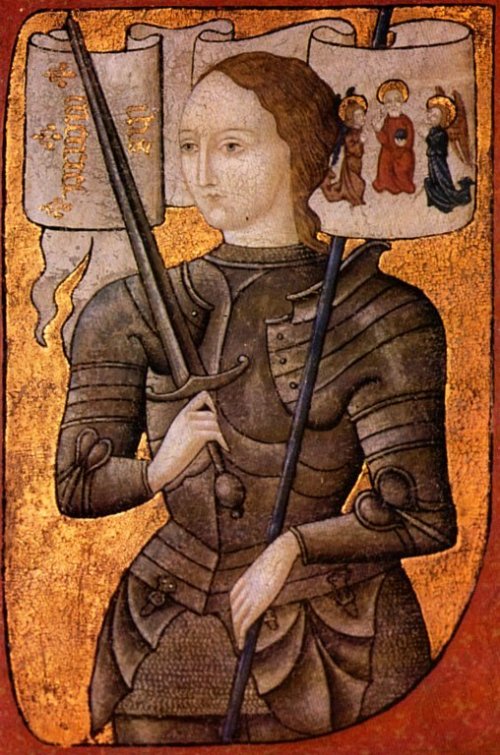Let me open up my series of posts on badass women in history by bragging about my husband.
For Valentine’s Day, he got me a book called Women Who Run with the Wolves. It’s a collection of myths to help you get in touch with the Wild Woman archetype. Why, I asked, baffled and delighted, did he get me a book of feminist folktales instead of flowers and candy? He replied, in an isn’t-it-obvious kind of way, “I want my wife to be a powerful woman.”
So I’ve been thinking about what it means to be a powerful woman and doing some reading on warrior women, pirate princesses and other righteous historical babes. I’m going to show you some of my favorites over the next few weeks, starting with Joan of Arc.
Joan of Arc was born in Domremy during a period of conflict between the French crown and Burgundy, which had allied with longstanding enemy England. At age thirteen, Joan began experiencing visions of saints, who initially told her to do typical things that incorporeal saints might tell you, like, “go to church”. But before long, the saints urged her to go to the aid of the king. Reasonably uncertain, especially because she was not trained in combat of any sort, Joan presented herself to the French commander Baudricourt, who berated her until she went away. However, the conflict in France worsened, and the saintly voices continued imploring her to fight for her country, so she sought out the commander again. He eventually conceded to take her to King Charles, who put Joan through a bit of royal rigamarole including dressing in a disguise to fool her (it didn’t) and sending her to a bishop to verify the authenticity of her visions. Once he was confident in her sanity, the king accepted her into the French military. Before she could begin her service, though, Joan insisted on searching for and unearthing an ancient sword, which she found with the assistance of her ghosty saints.
Seventeen-year-old Joan opened her military career by confronting the English king himself and pleading for the withdrawal of English troops from Orléans. Naturally, the king refused, so Joan led a campaign that captured all of the English forts surrounding the city within a week. Following this victory, Joan led and advised upon a number of additional battles that resulted in the French crown gaining control of Reims. From there, though, things got worse, as the French attempt on Paris proved unsuccessful and Joan was seriously wounded by a crossbow bolt. Immediately following her recovery, Joan entered battle again, but was thwarted when one of her countrymen, either by mistake or suspected treason, raised a drawbridge with Joan and several others still on it. She was captured and sold as a prisoner to the English and then subjected to a trial on the grounds of heresy. By all accounts, she faced her inquisition with honor and sincerity, but was eventually convicted for wearing men’s clothes — a clear sign of heresy, of course. The following day, she was burned at the stake. Twenty-four years later, her sentence was reversed (not much help to Joan) and today she is venerated as a saint in her own right by the Catholic church and an inspiration to women who stand by their convictions.

